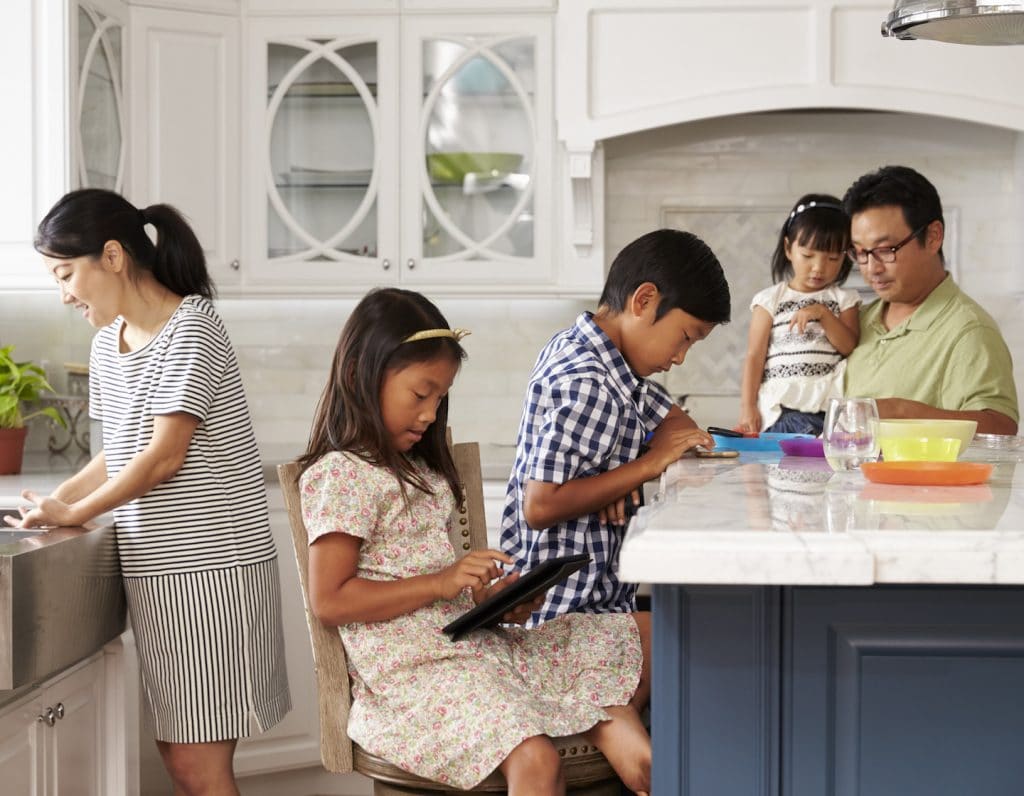
 Post Category - ParentingParenting
Post Category - ParentingParentingIt seems we can all freak out a little bit less about screen time. We grilled the experts for parenting advice in the digital age and came away with some pretty surprising recommendations…
Last week I was invited to attend “Parenting in the Digital Age,” a conference sponsored by Singapore’s Media Literacy Council (MLC). The occasion was the launch of the MLC’s newly revamped Clique Click, a parenting guide to smart media use for young children up through teens.
Read more: Parent Resources: Guide to Kids Internet Safety, Social Media & Screen Time
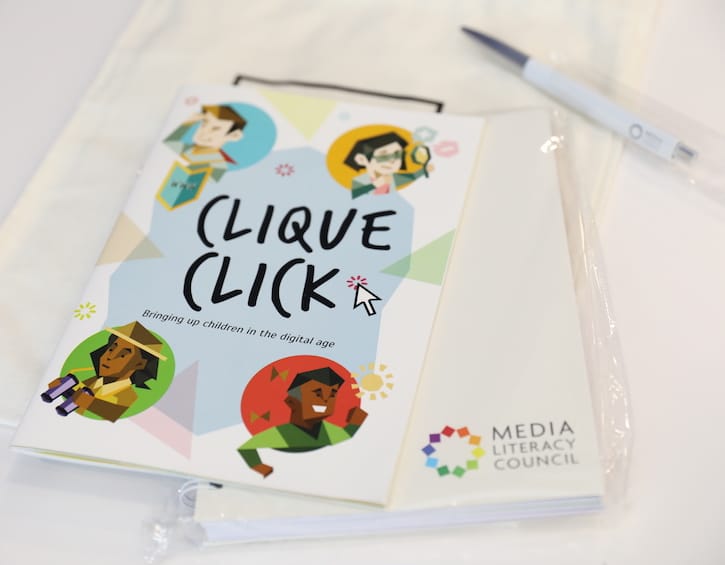
I highly recommend parents check out and download Clique Click, as it covers important questions like
- How do I keep my child safe from online threats?
- How much screen time is too much?
- How does my child’s time online change depending on their age?
- What if my child is a victim of cyber bullying?
- What if my child IS a cyber bully?
These are certainly topics that we’ve covered before, but what I found most fascinating about the conference overall was the key takeaway from an extremely knowledgeable and well-versed panel of experts (more on them in a minute):
Don’t try to stop your kids from using screens because one way or another – whether at home or with their friends at school – they’ll get to them, and in fact there are lots of benefits to technology and online interactions.
 To this end I was most struck by a quote from the conference’s keynote speaker, Professor Sonia Livingstone OBE from the London School of Economics, who’s a leading global authority on the subject of children, the media, and the Internet.
To this end I was most struck by a quote from the conference’s keynote speaker, Professor Sonia Livingstone OBE from the London School of Economics, who’s a leading global authority on the subject of children, the media, and the Internet.
“We tend to see parents around the world worrying about the length of time children are spending online, rather than asking the more pertinent question of whether the content that children are consuming is actually supporting their growth,” said Professor Livingstone. “If they focus more on the latter, parents will find that they can become more involved in their children’s digital journey, opening further bonding opportunities.”
Takeaway #1: Don’t Stress Too Much About Screen Time (or Age Requirements)
Professor Livingstone prompted quite the moment of self-reflection for me as she picked apart, one by one, parents’ various reasons (most of which are wholly legitimate!) for wanting to limit screen time:
“What are we worried about? What are the risks?” she asked. Screens affecting sleep? “Just don’t look at screens an hour before bed.” Encountering online predators? “It can take 5 minutes to groom a child,” she pointed out; screen time limits aren’t going to prevent it. Concerns about bullying or encountering pornography and violence are valid, of course, but Professor Livingstone, and the other panelists, made clear that research has shown these problems are best combatted by offline conversations reinforcing a family’s values and priorities.
Talking about empathy, frequently discussing the impact of words (and how they can either lose their meaning or be misinterpreted when written online rather than spoken to a person’s face), and of course modelling the desired behavior can all help.
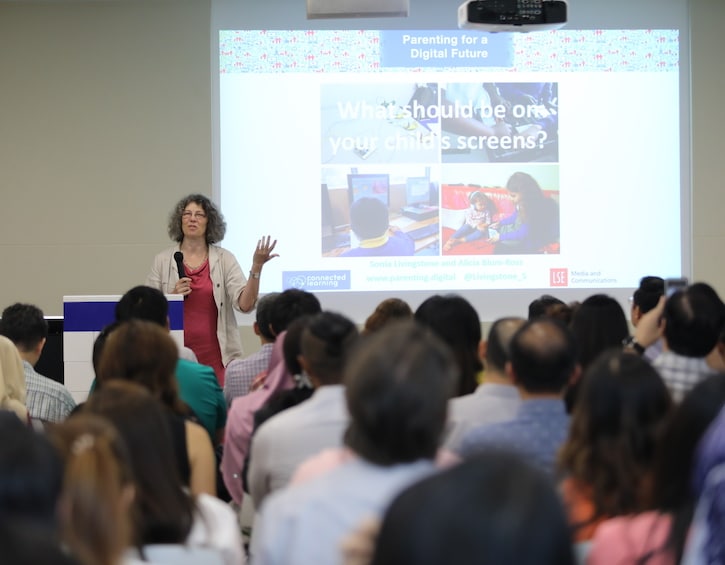
Takeaway #2: Don’t be so quick to blame screens for your child’s struggles
“I don’t know about you,” Dr. Livingstone said to the audience, “But I spend about 10 hours a day in front of a screen. No one seems worried about screen time’s impact on me.”
She continued, “Is your child not sleeping? Struggling with schoolwork? Not seeing friends? If that’s not the case, then I wouldn’t worry too much about screen time limits. There are many factors that can affect children and teens; screen time is only one of them.”
 “Media is just one facet of a child’s life,” said Lim Sun Sun, Professor of Media and Communication and Head of Humanities, Arts and Social Sciences at Singapore University of Technology and Design. “[Behaviors like moodiness, unsociability or not sleeping] can relate to greater dysfunction within the family, or other issues such as coming of age, puberty, trying out a new identity and so on.
“Media is just one facet of a child’s life,” said Lim Sun Sun, Professor of Media and Communication and Head of Humanities, Arts and Social Sciences at Singapore University of Technology and Design. “[Behaviors like moodiness, unsociability or not sleeping] can relate to greater dysfunction within the family, or other issues such as coming of age, puberty, trying out a new identity and so on.
“It’s easy to villanize the media to have the magic bullet answer, but their impact comes against the broader backdrop of social and societal transformations.”
Takeaway #3: View screen time not as a babysitter, but as an opportunity to bond with your child
Although everyone in attendance was in agreement that parents shouldn’t stress too much about strict limits on screen time, they also emphasized that quality of screen time matters.
It’s not ideal to use a phone or tablet as a babysitter at the dinner table, or to plonk your child down in front of the TV for hours (though surely every parent has been there, no judgement!).
 On the other hand, asserted Dr. Andrew Yee, a faculty fellow in Humanities, Arts and Social Sciences at SUTD with a research focus on young children and media, if parents can identify quality media, and take some time to consume the media with their children, there can be beneficial outcomes that encourage social and emotional development.
On the other hand, asserted Dr. Andrew Yee, a faculty fellow in Humanities, Arts and Social Sciences at SUTD with a research focus on young children and media, if parents can identify quality media, and take some time to consume the media with their children, there can be beneficial outcomes that encourage social and emotional development.
So what makes for good quality programming (or games, or apps)? According to Dr. Yee, content should:
- Engage
- Have meaningful lessons or messaging (such as talking about empathy, or the beauty of diversity)
- Encourage social interaction (such as when Daniel Tiger turns to the screen and asks the audience a question)
- Scaffold learning by providing opportunities to teach kids something new (for instance, the Netflix show Llama Llama prompted my daughter to ask where Llama’s father was, and led to a conversation about how not all families have a mother and father)
Parents consuming media with their kids once again circles back to the idea of discussing and reinforcing personal values through teachable moments. It’s also a wonderful way for parents to share hobbies with their children that they can ultimately take offline. On the younger side of the spectrum, Dr. Yee talked about watching YouTube videos of giant fish with his 3.5-year-old son. Professor Lim, meanwhile, gave the example of watching political coverage with her teenager and finding a launch point to talk about issues like fake news, propaganda, and the importance of detecting agendas.
“Whether you’re watching Daniel Tiger or a news clip,” Professor Lim explained, “there’s an opportunity to explain why you do or do not agree, and to have a thought-provoking discussion.”
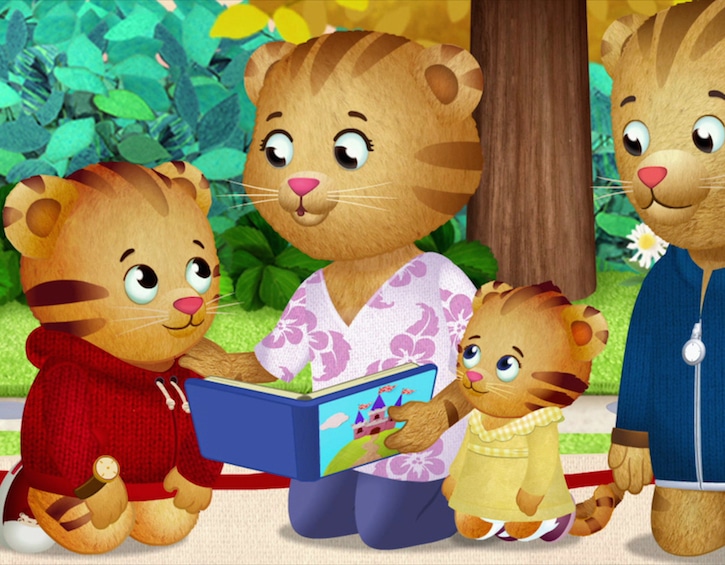
So what does Dr. Yee recommend, in his professional opinion? His top 5 shows and apps for kids are:
- Daniel Tiger’s Neighborhood (we love it, too!)
- Caillou (find it on YouTube)
- Sesame Street (“A classic!)
- The (FREE!) app Khan Academy Kids: “It exposes children to new concepts in an age-appropriate manner with a natural progression for scaffolding”
- Various PBS Kids apps: “There’s one I particularly like where kids can learn about cause and effect by experimenting with pouring water.” (Measure Up!, perhaps?)
Read more: Our Favourite Educational TV Shows for All Ages, from Toddlers to Teens
Concluded Dr. Yee:
“Media use becomes a problem when it replaces social interaction. But if you can use it to interact with your child, to understand why they like something, and have conversations about the content with them, that’s really important.”
Takeaway #4: Communication and Respect Go a Long Way
We are huge proponents of Respectful Parenting, and were hardly surprised when Dr. Yee mentioned that taking a respectful approach to establishing realistic screen time limits with kids – even when they’re as young as 3 – leads to more positive outcomes and less conflict.
In his research Dr. Yee has found that how parents talk to their children – whether in a more open, respectful, “discursive” manner, or in a more authoritarian and top-down manner – can have an effect on children’s perceived emotional climate.
“Is their autonomy being respected? Do you think they feel you are being responsive to their feelings?” he prompted the audience. Rule setting should be dependent on discussing and explaining WHY – not simply telling your kids ‘because I said so!’ There’s a difference between setting rules and being a controlling parent.”
We highly suggest checking out the “What’s Your Parenting Style” quiz (page 5) in Clique Click, which helps parents consider their own approach to authority and openness. There is also a handy Screen Time Contract on page 30, which allows parents and children to set out mutually agreed-upon limits that take into account factors such as homework, bedtime, and what/why content is inappropriate (such as pornography).
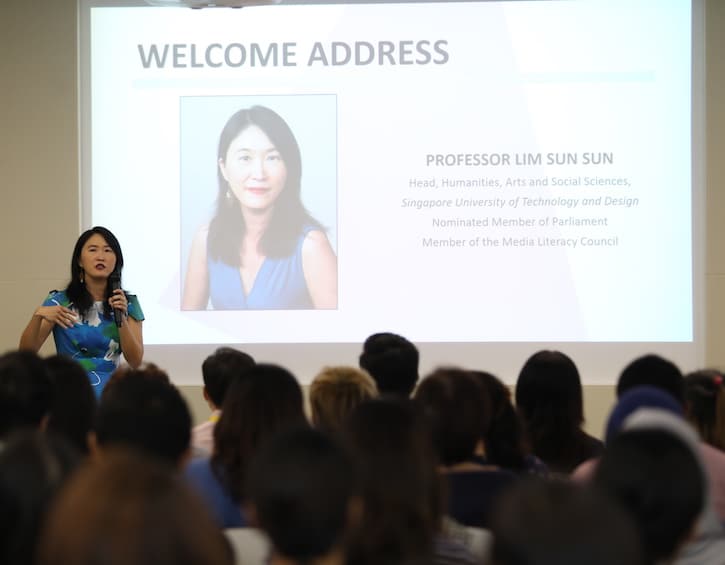
Takeaway #5: Screens are more than just a reward; for older kids they’re vital to their academic and social fabric
We all know that older kids need computers for writing homework assignments and doing research, and even many primary schools now incorporate iPads into their curricula. But more than that, Professor Lim pointed out, group projects will often have their own WhatsApp groups, and sometimes even teachers will communicate homework assignments via WhatsApp.
In other words, you can’t simply take your child’s phone or iPad away as punishment. (At the same time, Dr. Lim pointed out that teachers communicating via WhatsApp requires kids to feel like they need to be on-call 24/7. “We need to have a broader cultural conversation about technology’s 24/7 availability and demands, and I think it’s important to discuss boundaries with educators,” she said.
Crucially, she added, taking a draconian approach of taking away all screen time can lead to feelings of resentment and potentially threaten vital open communication channels between a parent and child.
“Your kids will feel cut off from their social networks. You’ll have a big obstacle in your relationship that would otherwise be resolved if you shifted your mindset and had a different conversation,” she cautioned.
“Blanket restrictions are just not particularly productive. Have a proper rationale and explain it to your child,” she says. “Pre-set rules conditions [such as the contract] are key,” because for all of us, it’s a basic psychological need to feel autonomous in everyday life (this is particularly so for teenagers exploring different identities). “If a parent restricts what a teen might feel is a core part of their identity, s/he will just re-assert autonomy in another way. Parents will definitely get a backlash,” she warned.
Takeaway #6: It is REALLY Hard to Recognize Cyber Bullying
“It’s very hard to identify,” said Dr. Livingstone, “We might know what a sad or anxious child looks like, but there could be many explanations (and not much communication from the child) as to the cause.”
Furthermore, she added, an online presence can “compound an existing vulnerability.” She also cautioned that research has shown that when something bad is going on, kids don’t tell teachers or parents, but rather their friends.” While it might be delicate talking to one of your child’s friends, parents need to find ways to keep sharing with their kids (she also suggested talking to siblings).
Along these lines, Dr. Lim also mentioned that her research has indicated that kids will hold back talking to their parents about cyber-bullying (even if it’s happening to someone else) because “they’re terrified their devices will be taken away from them.” As mentioned in takeaway #5, total denial is not a good solution; if your child feels confident that they can avoid that outcome, they may feel better about discussing online problems with you more openly.
Along these lines, Dr. Lim says she has found that family WhatsApp groups can be a great way to communicate with teens and keep lines of communication open, and that they have been found to encourage feelings of bonding.
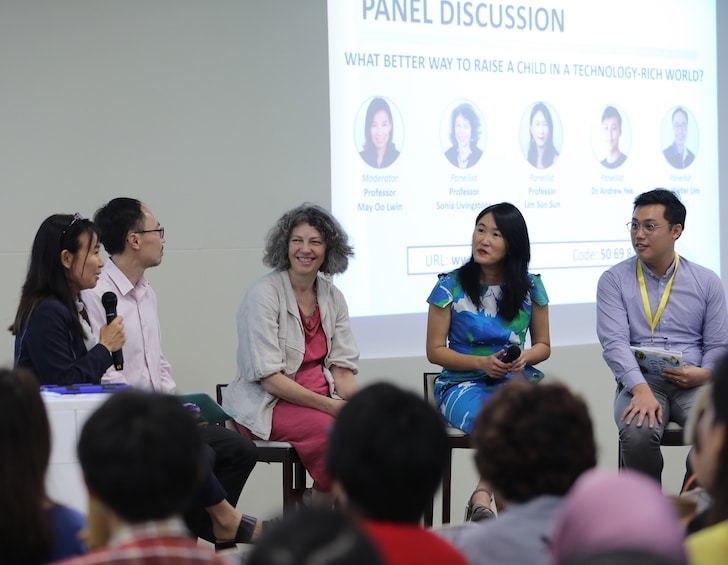
Takeaway #7: Your child probably isn’t addicted to devices
While I always thought it was a given that as a society we are addicted to our phones, and that you’re always hearing stories about online gaming addicts who spend days online and/or gamble away their money, according to the panel the research is far more mixed and inconclusive.
Dr. Livingstone conceded that, while the World Health Organisation has named an Online Gaming Disorder and also feels that Internet addiction is a real public health issue, “The discourse of addiction is really powerful and – perhaps – too casual.”
Dr. Yee is also skeptical. “I think you can start discussing these issues with your child as young as 3 years old,” he said. “I’ll explain to my son that he can watch a certain number of videos, but after that we need to stop because watching more is not so good for you – because it can hurt your eyes, make it harder to sleep, and so on – and he understands these basic terms, and he accepts that, and he actually does stop.” It’s empowering in a way when you start building an understanding with your child from the start.
“If you look at the literature on addiction,” added Dr. Sun, “some of the early research went down the ‘substance abuse’ route, drawing parallels such as hiding your habit from other people, needing higher and higher ‘doses’ to feel satisfied, the fact that your relationship with your family has broken down because of your addition and so on.
Read more: Why Fortnite is the New ‘F-Word’ for Mamas
“Of course, children have no sense of self-regulation. Give them something engaging and entertaining without limits, and of course they’ll play as long as they can – ‘as long as it makes me happy. I don’t need to sleep!’
“I don’t think ‘addiction’ is necessarily the appropriate term in that instance; it’s more about acknowledging that it’s an engaging medium. How do we then deal with the fact that at some point – however engaging – you have to draw the line somewhere? There is a point at which you need to sleep, you need to maintain healthy habits, you need to go to the bathroom, have a meal, and so on.
“I think that’s where parents come in with introducing a sense of self-care and personal responsibility.”
All in all I found the conference to be quite thought-provoking and enlightening. To me, the two recurrent themes were 1) No two children are the same (and therefore there’s no use prescribing one-size-fits-all numbers for screen time) and 2) Everything goes back to open and respectful communication between parent and child. If your child feels they can trust you, they are more likely to talk to you about their problems, rather than hide them and let them grow bigger. If you trust your child (and we know, it can be hard sometimes!), show them that by openly discussing the rationale behind your rules, and try to empathize by understanding the central role technology and social media play in their lives.
Be sure to visit www.betterinternet.sg for more information!
Read more:
10 Ways to Cultivate Safe and Healthy Social Media Habits for Your Kids
Top Tips to Boost Your Child’s Digital Intelligence from Singapore’s Better Internet Campaign






 View All
View All




 View All
View All









 View All
View All






